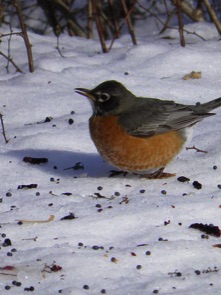It is, however, Emily Dickinson who most directly proclaims the Robin's song our song of place in a poem that defines key elements of the Emersonian project of transcribing nature: the emphasis on organic form, the celebration of the ordinary, the transitiveness of form and meaning as "taught" by the passing seasons, and the discipline of seeing learned in the tabula rasa of a New England winter.
Thrush Music: American Poet-Naturalists and the Poetics of Loss | p 2
The Robin's my Criterion for Tune—
Because I grow — where Robins do —
But, were I Cuckoo born —
I'd swear by him—
The ode familiar — rules the Noon —
The Buttercup's, my Whim for Bloom —
Because, we're Orchard sprung —
But, were I Britain born,
I'd Daisies spurn —
None but the Nut — October fit —
Because, through dropping it,
The Seasons flit — I'm taught —
Without the Snow's Tableau
Winter, were lie — to me —
Because I see — New Englandly —
The Queen, discerns like me —
Provincially —
Here the tension between poet and naturalist is felt in the tension between the speaker's self-assertion — my criterion, my whim — and the assertiveness of the thing itself—Robin, butter-cup, nut, snow. To see New Englandly is neither to inherit a condition of place nor to impose a landscape of the mind, but to engage in the work of seeing, which comes, as Emerson says, "by the intellect being where and what it sees." Thoreau, as usual, turns Emersonian theory into his own patient practice when he says, "I have found that it requires a different intention of the eye, in the same locality, to see different plants." For the poet-naturalist, form and meaning arise from the collaboration of self and locality; they are the longed-for and graceful harvest of work in place.
